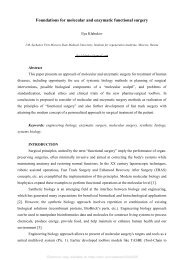Engineering Biology Problems Book (2021, Obninsk Edition)
Create successful ePaper yourself
Turn your PDF publications into a flip-book with our unique Google optimized e-Paper software.
pathology has developed in the patient due to the growth of hypernephroma? Describe this pathology
using the data from the task. 2. What is the cause of this form of pathology? 3. What are the
mechanisms of its development and the symptoms that the patient has? 4. What other types of primary
and secondary forms of this pathology can occur in humans?
© P. F. Litvitsky "Tasks and test tasks in pathophysiology". Moscow: GatarMed, 2002 (task 59)
SOLUTION: 1. The patient developed secondary (acquired) absolute erythrocytosis – a pathological
condition characterized by an increase in the concentration of red blood cells (erythrocytes) in the
bloodstream. It is characterized by increased erythropoiesis in the bone marrow and the release of
excess red blood cells into the vascular channel. The number of red blood cells in the blood
сonsequently increases (7.5×10 12 /l), reticulocytes (10 %), the level of Hb (up to 180 g/l), Ht (0.61),
blood pressure increases (150/90 mm Hg). 2. In this case, the cause of the secondary absolute
erythrocytosis development is the hyperproduction of erythropoietin (its level in the blood is 20%
higher than normal) by the tumor cells of the right kidney. 3. An increase in the level of erythropoietin
in the blood causes the stimulation of erythropoiesis in the bone marrow and the release of excess red
blood cells (including their young forms) into the circulating blood. This, in turn, leads to
erythrocytosis, an increase in Ht and Hb content in the blood. Increased blood pressure is the result of
erythrocytosis, which caused hypervolemia. 4. Types of erythrocytosis: primary - erythremia (for
example, Vaquez's disease), familial (inherited) erythrocytosis; secondary - absolute and relative.
2.25 Blood pathophysiology-II. A 50-year-old patient, a photographer, was hospitalized with
complaints of an increase in the lymph nodes of the neck, which he began to notice during the last
month. Objectively: the skin is of ordinary color. Enlarged cervical and subclavian lymph nodes are
palpated, the size of beans and hazelnuts, of a dough-elastic consistency, mobile, not soldered to each
other and the surrounding tissues, painless. From the side of the chest organs without features. The
liver is not enlarged. The lower pole of the spleen is palpated (16 cm long). The blood test showed:
Hb 123 g/l, erythrocytes 4,7×10 12 /l, color index 0.9, l. 51,0x10 9 /l, e. 0, 5%, p. 1%, p. 24. 5%,
monocytes 2%, lymphocytes 72%, platelets 210×10 9 /l, ESR 17 mm per hour. Among the peripheral
blood lymphocytes, small narrow-cytoplasmic forms (almost bare nuclei) predominate, and
Botkin-Gumprecht shadows are found in a significant amount. Prolymphocytes make up 1.5%. 1.
What kind of disease can you think about in this case? 2. What confirms this disease? 3. What is the
stage of leukemia in the patient?
4. What are the most common complications in patients and why?
© P. F. Litvitsky "Tasks and test tasks in pathophysiology". Moscow: GatarMed, 2002 (task 59)
SOLUTION: 1. The patient has chronic lymphocytic leukemia (CLL), which is 85% of cases that
arise from the precursors of B-lymphocytes. There are two types of B-CLL: B-CLL, the substrate of
which is the cells of the T-independent pathway of differentiation, and B-CLL, the substrate of which
is the memory B-cells of the T-dependent pathway of differentiation. In the latter case, the disease is
more benign. 2. The age of the patient, an increase in the lymph nodes of the neck and a blood test
(leukocytosis up to 50-200×10 9 /l), lymphocytosis, and relative neutropenia. Small lymphocytes with a
narrow ring of cytoplasm located on the periphery of the nucleus. Typical in a blood smear is
Botkin-Gumprecht corpuscles. These are artifacts of tumor cells that occur during the preparation of
smears. 3. The patient has stage II since splenomegaly is observed and there is no anemia. 4. Anemic,
hemorrhagic syndromes are caused by damage to the bone marrow and the appearance of antibodies
to red blood cells and platelets. Infectious complications are caused by hypogammaglobulinemia,
disturbance of the cellular link of immunity. Allergic reactions of the immediate type (most often on
vaccinations, mosquito bites).
2.26 Knockout of filaments. Intermediate filaments are a class of cytoskeletal filaments with a
diameter of about 10 nm, which are composed of five types of structural proteins, each of which is
tissue-specific: neurofilament proteins (molecular weight 65, 100, and 135 kD), fibrillar acid protein
GFAP (50 kD), cytokeratin, desmin, and vimentin. Although knockouts of some intermediate
filaments genes manifest a certain phenotype in mice, knockouts of genes of vimentin or another
member of the vimentin family, glial fibrillar acid protein (GFAP), do not manifest themselves.
However, in mice with knockouts of both vimentin and GFAP, the functions of astrocytes, which are












